Eclipses, transits, and extra solar planets
A workshop by Linda Shore, Paul Doherty and Eric Muller
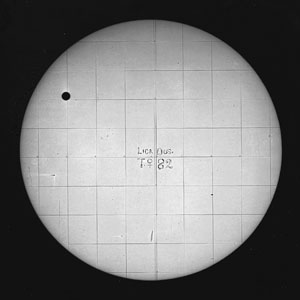
An image of the 1882 transit of Venus recorded at Lick
Observatory, California.
Eclipses, transits, and extra solar planets
A workshop by Linda Shore, Paul Doherty and Eric Muller

An image of the 1882 transit of Venus recorded at Lick
Observatory, California.
The Eclipse
On Sunday, May 20, 2012 there will be an annular solar eclipse visible from a 50 mile wide swath across California and Nevada. With the moon near its apogee, its farthest distance from earth. The small angular size of the moon means that it will not completely cover the sun, instead an annulus of the suns surface will show surrounding the moon.
Here is the NASA map and timing for the eclipse http://eclipse.gsfc.nasa.gov/SEgoogle/SEgoogle2001/SE2012May20Agoogle.html
And one based on the nautical almanac http://astro.ukho.gov.uk/eclipse/0132012/

Reload this page to see the animation.
In San Francisco, the eclipse starts at 5:16 PM reaches its maximum at 6:33 and concludes at 7:40.
At maximum 84% of the sun will be covered making a letter C
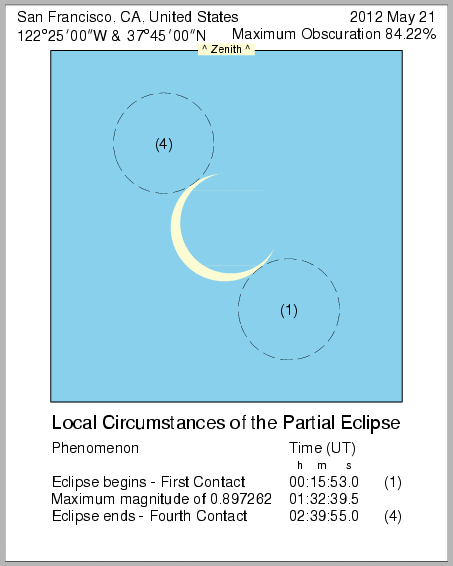
Note the time here is Universal time which must be converted to local time in California.
I use Time zone converter.
There will also be a total solar eclipse on November 13 in Cairns Australia with about 2 minutes of totality. It is mostly over water but is visible in Australia at sunrise.
info here http://astro.ukho.gov.uk/eclipse/0312012/
The Transit
On June 5, 2012 Venus will pass across the face of the sun as viewed from: North America and Asia.
Information can be found here http://www.transitofvenus.org/
The last transit was in 2004, the next transit of venus will be in 2117, 105 years from now.
Most of the transit will be visible from San Francisco. Get timings for the transit here: http://transitofvenus.nl/wp/where-when/local-transit-times/
In San Francisco the transit first contact will be at 15:06:32 , second contact at 5:23:59, third and fourth contacts will be after sunset.
Extrasolar planets
Extrasolar planets are cataloged by the New Worlds Atlas.
We have identified hundreds of planets outside the solar system, with over a thousand more candidates waiting to be verified.
They are discovered using several techniques including the observation of transits.
Then a planet's mass is found by observing the doppler shift of light from their star, as the planet swings the star around in a small circle. Or by the perturbation of one planets orbit by another.
This workshop
Linda Shore activity for the Transit of Venus.
Paul Doherty activity
Finding the astronomical unit by observing a transit.
viewing and projecting the partial eclipse and transit safely.
Doppler Effect Demonstrator. Snack
Seeking Glorious Transits a science fact column in the magazine of fantasy and science fiction by Paul Doherty and Pat Murphy
Eric Muller Activity using a photometer.
Linda Shore Powerpoint on Extra solar planets
Paul Doherty simple calculations:
Transit of Venus
To see what the transit will look like when viewed by eye through a proper solar filter, find a white disk for example 7.5 inches(19 cm)in diameter .
Make a black disk 1/30 the diameter of the circle. 7.5/30 = 1/4 inch ( 3 mm) which is the size of a hole punch. So use a hole punch to cut out a black disk. Then attach the black disk to the circle.
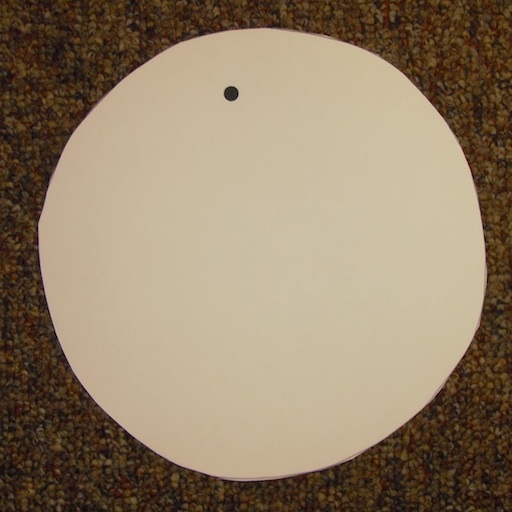
This will be how large Venus will appear against the sun. Then move 100 plate diameters away from the plate. For our 7.5 inch sun disk this is 750 inches, or 750/12 = 62.5 feet, or 19 meters.
Additional model using a black disk magnet 0.0625 inches ( 5mm) in diameter I made a white disk 30 times larger or 9 inches ( 25 cm)
How to find the angular diameter of the sun. The angular diameter of the sun is about 1/2 of a degree or about 1/100 of a radian (actually 1/110 radians)
1 AU = 1.50 *10^8 km distance from sun to earth
Venus orbital period 225 days.
Venus orbital radius R = 1.08 * 10^8 km = 0.718 AU
Venus radius r = 6 x 10^3 km = 0.95 earth radii.
Angular Diameter of Venus at closest point to earth is 66 seconds of arc. 0.018 degree, or 3.4 * 10^-4 radian
Orbital inclination of venus orbit relative to ecliptic A = 3.4 degrees or 0.06 radian
Venus Orbit Model. Take a picnic plate and cut a disk out of it. Mark a circle inside this disk with a diameter of 0,7 times the diameter of the disk.
Draw a diameter across this inner disk. Use a sharp knife to cut out the inner disk but leave it connected where the diameter touches the edges of the disk.
Tip up the inner disk. The edge of the outer disk is the orbit of the earth, the edge of the inner disk is the orbit of venus which is tilted 3.4 degrees. This is why transits are rare, they can only occur as Venus crosses the plane of the earth's orbit
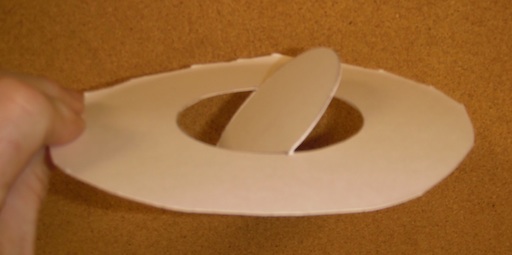
Distance of venus above sun earth line at maximum inclination, d = A * R = 0.06 * 108*10^6 = 6.5 * 10^6 km
So at maximum inclination venus is 6.5*10^6/10^3 = 6.5 *10^3 venus diameters above the plane of the ecliptic.
Angular distance of venus above the ecliptic as viewed from earth 7.8 * degrees. Angular diameter of the sun 0.5 degrees. So Venus can be 15 times the angular diameter of the sun above the sun.
The transit of 1882 was photographed from Lick observatory. 140+ images were taken of the transit on glass plates. These plates have been scanned and turned into an animation.
View it here http://earthsky.org/space/bill-sheehan-and-tony-misch-video-of-1882-venus-transit
A modern 4 minute video on Transits.
http://www.youtube.com/watch?v=ehHY9fTrb7Q&feature=youtu.be
During the Transit of Venus in 1761 Venus the Russian astronomer Mikhail Lomonosov found that Venus had an Atmosphere. As Venus approached the sun it was seen to be surrounded by a glow as sunlight refracted through the atmosphere.

During the same transit scientists measured more accurately than ever before the size of the solar system, in particular the Astronomical Unit.
However the accuracy was limited by the "Black Drop effect" in which Venus appears to stretch out and remain connected to the edge of the sun.
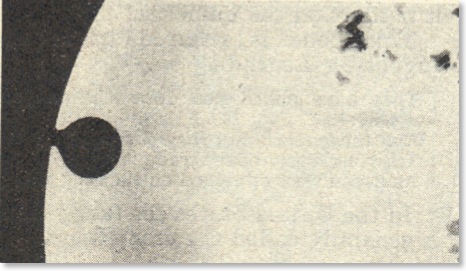

You can learn a lot about transits of Venus on the Exploratorium Website.
Finding the Astronomical Unit by viewing a transit. http://www.exploratorium.edu/venus/question4b.html
Demonstrations
Venus is called Earth's twin because it is almost the same size as earth. The surface gravity of Venus is 0.8g you would weigh 20% less on Venus. If you weigh 150 lb. on earth you would weigh 120 pounds on Venus.
Venus has a hot dense atmosphere made of 95% carbon dioxide gas, plus nitrogen and argon.
The atmosphere of Venus is about 30 times denser than the atmosphere of earth.
This is the result of the higher surface pressure which is 90 times the pressure at the surface of the earth combined with the high temperatures of Venus due to its closeness to the sun and its greenhouse effect. The atmosphere is less dense because of its temperature which is 750 K or about 475 °C by the ratio of the earth temperature of 273 K to Venus' temperature or 273/ 750 about 1/3.
The air on earth is 1/800 as dense as water so the air on Venus is about 0.04 as dense as water. It's a lot denser than air but still less dense than water. Did you ever have those dreams where you are trying to run but the air is thick?
|
Scientific Explorations with Paul Doherty |
|
14 April 2012 |